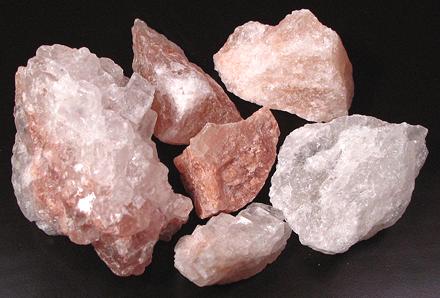 [Khewra salt]
[Khewra salt]
This salt comes from the huge Khewra salt mine in Pakistan, in the Salt Range, about 190 miles south of the Himalayas. Why is it called "Himalayan"? Because as any marketing guru will tell you, you can charge four, six, even 10 times as much under that more romantic name than if you called it "Pakistani".
Basically, this is Precambrian and early Cambrian sea salt, laid down about 540 million years ago. Seawater had a different composition that far in the past, and It has been contaminated with some minerals by circulating ground water. This is mostly iron and sulphates, the iron giving it the pink color. For more on the included minerals, see Health & Nutrition below.
Large hunks of this salt are used to make baking stones, for lining saunas, and for making decorative lamps. The potential supply is very large - we won't run out any time soon.
The photo specimens were purchased from an Indian market in Glendale, California, labeled simply "Natural Crystal Salt" - but they still charged over 2021 US $2.99 per pound. Yes, it tastes pretty much like salt - but at least you can be pretty sure it isn't refined. If you buy it ground, you can't tell what it might be, and it is often faked up in India.
More on Salts.
In contrast, our current Sea Salt is about 85.6% Sodium Chloride and 14.4% other minerals, so is far richer in trace minerals than Himalayan Pink Salt. Sea salt is also low in iron, thus uncolored. Iron is a mineral we can easily get more than enough of from much richer sources.
sa_sapnkz 211108 - www.clovegarden.com